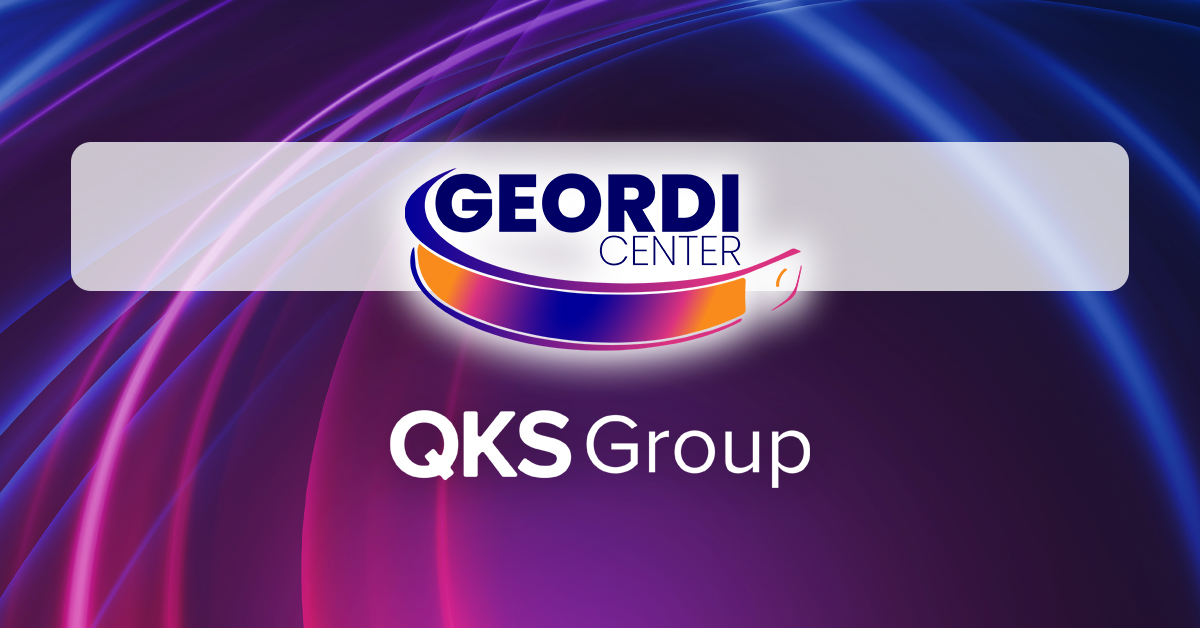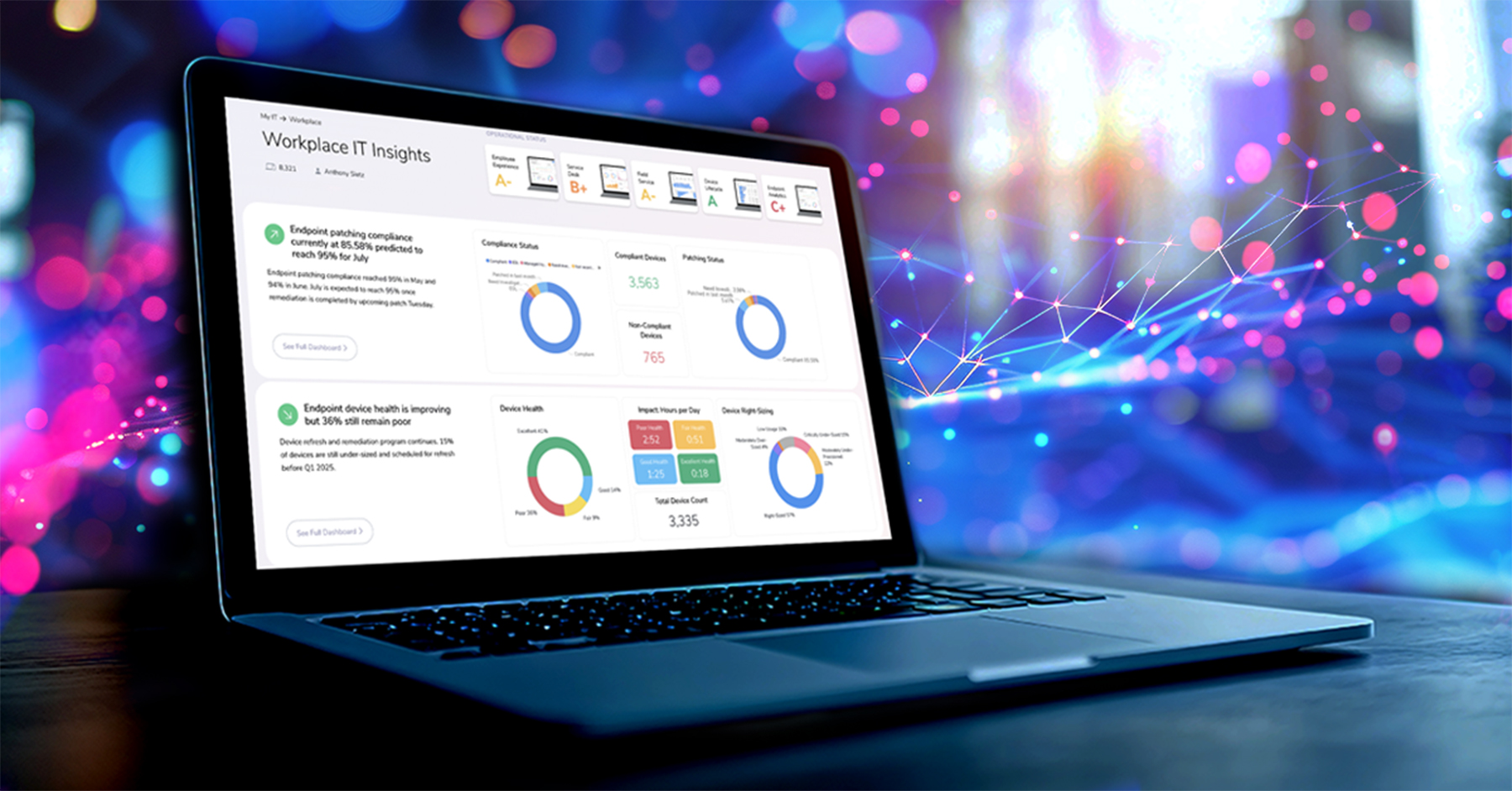- Managed Infrastructure and Cloud Services
- Advanced Technology


Emma Mak • Staff Writer
Healthcare organizations are up against it. They must deliver high-quality patient care, ensure compliance with regulations, manage complex IT infrastructures, and cope with internal and external stakeholders’ increasing demands and expectations.
Two powerful technologies can help: Artificial Intelligence for IT Operations (AIOps) and Digital Experience Management (XM) enable organizations to optimize IT operations and enhance Digital Employee Experience (DEX). Combined, they’re a remedy for what ails many healthcare organizations — inefficient systems and staff burnout — ultimately leading to improved patient outcomes.
How to Get Started with AIOps and XM
As with all digital transformation initiatives, successful implementation of AIOps and XM requires a strategic and systematic approach. Here are some steps to follow:
- Assess your current state: Evaluate your IT maturity, capabilities, and challenges, and identify your goals and priorities for AIOps and XM.
- Choose the right tools: Select the best AIOps and XM solutions and vendors that suit your needs and budget and can integrate well with your existing IT environment and processes.
- Implement and optimize: Deploy and configure your AIOps and XM solutions and monitor and measure their performance and impact. Continuously refine and improve your AIOps and XM strategies and practices based on data and feedback.
These steps can be challenging for healthcare organizations on their own. Implementing AIOps and XM is more complex than purchasing software. A managed services provider (MSP) with expertise in implementing and integrating toolsets within customers’ systems can be a great partner throughout the process, helping you gain the best ROI.
AIOps and XM Defined
AIOps is a set of tools and techniques that use AI, machine learning, and automation to analyze, monitor, and manage IT systems and processes. Implemented correctly, it can help IT teams reduce complexity, increase efficiency, and resolve issues faster and more proactively.
XM is a holistic approach that measures and improves how employees interact with and perceive the digital tools and systems they use daily. This helps IT teams provide seamless, user-friendly, and personalized experiences that boost employee engagement, productivity, and retention.
By using AIOps to group related alerts using event correlation, the healthcare organization successfully reduces alert fatigue and improves incident management for their EHR system.
AIOps + XM Benefits: Monitoring and Improving IT Infrastructure Health
By combining AIOps and XM, healthcare organizations can achieve the following benefits:
- Reduced downtime, cost, and risk: AIOps can help IT teams prevent, detect, and resolve incidents that affect the availability and performance of critical IT systems and applications, such as electronic health records, telehealth platforms, and medical devices. It can also help IT teams optimize resources, reduce operational costs, and comply with security and privacy regulations.
- Improved employee satisfaction and performance: XM can help IT teams understand which digital processes are slowing down and frustrating doctors, nurses, administrators, and researchers. By enabling the collection and analysis of staff feedback, sentiment, and tool usage data, IT teams can identify and address pain points, bottlenecks, and opportunities for improvement.
- Enhanced patient care and outcomes: Together, AIOps and XM ensure healthcare IT systems and applications are reliable, secure, and user-friendly, helping staff become less stressed and more productive and efficient. This leads to better patient satisfaction, safety, and quality of care, as well as reduced errors, costs, and risks.
Real-World Examples
“Technology should help maximize healthcare worker efficiency rather than add to their burden.”
AIOps
- Challenge: A hospital’s IT team is inundated with alerts when the EHR system experiences a network outage that affects multiple servers and applications. Meanwhile, an incident that affects patient privacy is lost in the alert noise.
- Solution: AIOps helps IT teams cut through the noise. In this case, it would have grouped all the alerts related to the network outage into one incident and prioritized the data breach incident affecting patient privacy, assigning it critical status so it could be resolved quickly.
XM
- Challenge: A nurse needs to access patient electronic health records (EHR) on her tablet. She’s having trouble— the app is slow and unresponsive, and she must wait to view each patient’s information. It’s the end of her shift; it’s been a difficult day, and she’s exhausted and frustrated.
- Solution: Using XM, the IT team would have been monitoring the performance and reliability of the EHR app, proactively identifying and resolving any issues that could affect user experience. While her day full of caring for patients would still have been challenging, her experiences with technology would have helped maximize her efficiency in caring for her patients rather than adding to her burden.
Compucom’s Matrix Platform
We’ve designed our comprehensive portfolio of IT services around user experience and XM, and we’re an early adopter of AIOps tools and techniques. Our experience and automation platform — Matrix — combines AIOps and XM to drive transformation, innovation, and continuous process improvement throughout your IT environment, freeing up time for your IT team to focus on other critical initiatives that can further improve patient care.
RecenT

Future-Ready IT: Strategies to Optimize, Adapt, and Lead Through Uncertainty

Reimagining IT with the FLO Framework: Inside Compucom’s Geordi Center for Interactive Managed Services and Digital Workplace Solutions

Opportunity in Uncertainty: Optimize Your Remote, Hybrid, or In-Office Setup

9 Ways Strategic IT Staffing Empowers Organizations

Case Studies: Asset Intelligence and Endpoint Compliance Made Easy

AI and the Enterprise: The Future of IT Management
TOPICS
Optimizing Healthcare IT Infrastructure with AI
- Managed Infrastructure and Cloud Services
- Advanced Technology

Emma Mak • Staff Writer
Healthcare organizations are up against it. They must deliver high-quality patient care, ensure compliance with regulations, manage complex IT infrastructures, and cope with internal and external stakeholders’ increasing demands and expectations.
Two powerful technologies can help: Artificial Intelligence for IT Operations (AIOps) and Digital Experience Management (XM) enable organizations to optimize IT operations and enhance Digital Employee Experience (DEX). Combined, they’re a remedy for what ails many healthcare organizations — inefficient systems and staff burnout — ultimately leading to improved patient outcomes.
How to Get Started with AIOps and XM
As with all digital transformation initiatives, successful implementation of AIOps and XM requires a strategic and systematic approach. Here are some steps to follow:
- Assess your current state: Evaluate your IT maturity, capabilities, and challenges, and identify your goals and priorities for AIOps and XM.
- Choose the right tools: Select the best AIOps and XM solutions and vendors that suit your needs and budget and can integrate well with your existing IT environment and processes.
- Implement and optimize: Deploy and configure your AIOps and XM solutions and monitor and measure their performance and impact. Continuously refine and improve your AIOps and XM strategies and practices based on data and feedback.
These steps can be challenging for healthcare organizations on their own. Implementing AIOps and XM is more complex than purchasing software. A managed services provider (MSP) with expertise in implementing and integrating toolsets within customers’ systems can be a great partner throughout the process, helping you gain the best ROI.
AIOps and XM Defined
AIOps is a set of tools and techniques that use AI, machine learning, and automation to analyze, monitor, and manage IT systems and processes. Implemented correctly, it can help IT teams reduce complexity, increase efficiency, and resolve issues faster and more proactively.
XM is a holistic approach that measures and improves how employees interact with and perceive the digital tools and systems they use daily. This helps IT teams provide seamless, user-friendly, and personalized experiences that boost employee engagement, productivity, and retention.
By using AIOps to group related alerts using event correlation, the healthcare organization successfully reduces alert fatigue and improves incident management for their EHR system.
AIOps + XM Benefits: Monitoring and Improving IT Infrastructure Health
By combining AIOps and XM, healthcare organizations can achieve the following benefits:
- Reduced downtime, cost, and risk: AIOps can help IT teams prevent, detect, and resolve incidents that affect the availability and performance of critical IT systems and applications, such as electronic health records, telehealth platforms, and medical devices. It can also help IT teams optimize resources, reduce operational costs, and comply with security and privacy regulations.
- Improved employee satisfaction and performance: XM can help IT teams understand which digital processes are slowing down and frustrating doctors, nurses, administrators, and researchers. By enabling the collection and analysis of staff feedback, sentiment, and tool usage data, IT teams can identify and address pain points, bottlenecks, and opportunities for improvement.
- Enhanced patient care and outcomes: Together, AIOps and XM ensure healthcare IT systems and applications are reliable, secure, and user-friendly, helping staff become less stressed and more productive and efficient. This leads to better patient satisfaction, safety, and quality of care, as well as reduced errors, costs, and risks.
Real-World Examples
“Technology should help maximize healthcare worker efficiency rather than add to their burden.”
AIOps
- Challenge: A hospital’s IT team is inundated with alerts when the EHR system experiences a network outage that affects multiple servers and applications. Meanwhile, an incident that affects patient privacy is lost in the alert noise.
- Solution: AIOps helps IT teams cut through the noise. In this case, it would have grouped all the alerts related to the network outage into one incident and prioritized the data breach incident affecting patient privacy, assigning it critical status so it could be resolved quickly.
XM
- Challenge: A nurse needs to access patient electronic health records (EHR) on her tablet. She’s having trouble— the app is slow and unresponsive, and she must wait to view each patient’s information. It’s the end of her shift; it’s been a difficult day, and she’s exhausted and frustrated.
- Solution: Using XM, the IT team would have been monitoring the performance and reliability of the EHR app, proactively identifying and resolving any issues that could affect user experience. While her day full of caring for patients would still have been challenging, her experiences with technology would have helped maximize her efficiency in caring for her patients rather than adding to her burden.
Compucom’s Matrix Platform
We’ve designed our comprehensive portfolio of IT services around user experience and XM, and we’re an early adopter of AIOps tools and techniques. Our experience and automation platform — Matrix — combines AIOps and XM to drive transformation, innovation, and continuous process improvement throughout your IT environment, freeing up time for your IT team to focus on other critical initiatives that can further improve patient care.
Recent Blogs

Future-Ready IT: Strategies to Optimize, Adapt, and Lead Through Uncertainty

Reimagining IT with the FLO Framework: Inside Compucom’s Geordi Center for Interactive Managed Services and Digital Workplace Solutions

Opportunity in Uncertainty: Optimize Your Remote, Hybrid, or In-Office Setup

9 Ways Strategic IT Staffing Empowers Organizations

Case Studies: Asset Intelligence and Endpoint Compliance Made Easy




